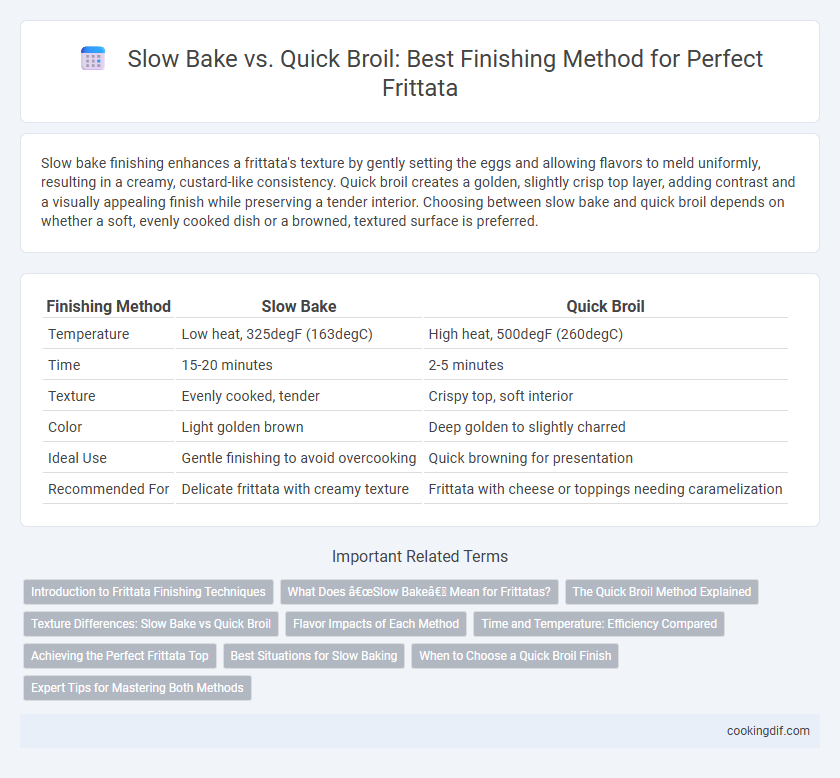Slow bake finishing enhances a frittata's texture by gently setting the eggs and allowing flavors to meld uniformly, resulting in a creamy, custard-like consistency. Quick broil creates a golden, slightly crisp top layer, adding contrast and a visually appealing finish while preserving a tender interior. Choosing between slow bake and quick broil depends on whether a soft, evenly cooked dish or a browned, textured surface is preferred.
Table of Comparison
| Finishing Method | Slow Bake | Quick Broil |
|---|---|---|
| Temperature | Low heat, 325degF (163degC) | High heat, 500degF (260degC) |
| Time | 15-20 minutes | 2-5 minutes |
| Texture | Evenly cooked, tender | Crispy top, soft interior |
| Color | Light golden brown | Deep golden to slightly charred |
| Ideal Use | Gentle finishing to avoid overcooking | Quick browning for presentation |
| Recommended For | Delicate frittata with creamy texture | Frittata with cheese or toppings needing caramelization |
Introduction to Frittata Finishing Techniques
Slow bake offers evenly distributed heat, ensuring a tender, creamy frittata interior with a gently browned top. Quick broil creates a rapid, high-heat finish that crisps and caramelizes the surface, adding texture and a golden hue. Choosing the finishing technique depends on desired texture and time available, with slow bake preferred for consistency and broil for speed and crunch.
What Does “Slow Bake” Mean for Frittatas?
Slow bake for frittatas involves cooking at a low, steady temperature, typically around 325degF (163degC), to ensure even heat penetration and a creamy, custard-like texture. This method allows the eggs to set gently without curdling, preserving the moisture and enhancing the flavor. Slow baking also helps the vegetables and cheese in the frittata meld perfectly, resulting in a tender, uniform finish.
The Quick Broil Method Explained
The quick broil method for finishing a frittata involves placing it under high heat for a few minutes to rapidly brown and crisp the top, enhancing texture and flavor without overcooking the interior. This technique typically uses a broiler set to high temperature, allowing the egg mixture to develop a golden crust while maintaining a creamy center. Compared to slow baking, broiling offers a faster finish, making it ideal for achieving a visually appealing and appetizing dish in less time.
Texture Differences: Slow Bake vs Quick Broil
Slow bake finishing produces a tender, evenly cooked texture in frittatas, allowing eggs to set gently without browning too quickly. Quick broil creates a contrasting crisp and golden top layer, adding a slightly caramelized flavor but can risk uneven cooking or dryness if overdone. Choosing slow bake preserves moisture and softness, while quick broil emphasizes a textural contrast with a browned crust.
Flavor Impacts of Each Method
Slow baking a frittata enhances flavor by allowing eggs and ingredients to meld gradually, resulting in a creamy texture and richer, well-developed taste. Quick broiling creates a caramelized, slightly crispy top that adds contrast and a toasty flavor but can risk overcooking if not monitored closely. Choosing slow bake versus quick broil directly impacts the final flavor profile, balancing creaminess and browning intensity.
Time and Temperature: Efficiency Compared
Slow bake finishes a frittata at a lower temperature around 325degF (163degC) for 15-20 minutes, ensuring even cooking and a creamy interior. Quick broil uses high heat at 500degF (260degC) for 2-4 minutes, rapidly browning the top but requiring close monitoring to prevent burning. Slow baking offers consistent results with gentle heat, while quick broiling prioritizes speed and a crisp finish.
Achieving the Perfect Frittata Top
Slow baking a frittata ensures even cooking and a tender, custard-like texture by gently setting the eggs, while quick broiling provides a fast, golden-brown top with a slightly crispy finish. Achieving the perfect frittata top involves balancing heat and time: slow bake offers controlled heat for consistent doneness, whereas quick broil delivers immediate browning but risks overcooking if left too long. For a flawless result, finishing with slow baking followed by a brief broil combines smooth interior texture with an appealing, lightly browned surface.
Best Situations for Slow Baking
Slow baking a frittata is ideal for producing a tender, evenly cooked texture and is best suited for thick, vegetable-rich recipes that require thorough cooking without browning too quickly. This method is perfect when aiming for a custardy interior and a delicate top, as it allows flavors to meld gently at a controlled, lower temperature. Slow baking also reduces the risk of burning or overcooking the edges, making it suitable for large portions or frittatas with dairy-heavy fillings like cheese and cream.
When to Choose a Quick Broil Finish
A quick broil finish is ideal for frittatas when you want a golden, slightly crispy top without overcooking the interior, especially after slow baking has fully set the eggs. This method is perfect for adding a browned, bubbly cheese crust or caramelized vegetables in the final minutes of cooking. Use quick broil to achieve a visually appealing, textural contrast while maintaining the creamy, custard-like texture inside the frittata.
Expert Tips for Mastering Both Methods
Slow baking a frittata ensures even cooking and a tender, custard-like texture by gently setting the eggs at a low temperature, ideal for incorporating delicate ingredients like cheese and herbs. Quick broiling rapidly creates a golden, slightly crispy top layer, perfect for achieving a visually appealing finish while intensifying flavors through caramelization. Expert chefs recommend monitoring closely during broiling to prevent burning and using a preheated oven for slow baking to maintain consistent heat throughout the cooking process.
Slow Bake vs Quick Broil for finishing Infographic

 cookingdif.com
cookingdif.com